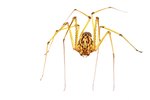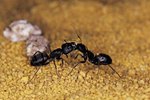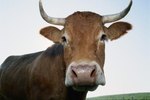
While not generally welcome at family picnics, the ant is a long-standing source of fascination for adults and children alike. Biologist Edward O. Wilson, author of "The Social Conquest of Earth," estimates 10,000 trillion ants live among us. More than 12,000 recognized ant species exist worldwide, and new species are discovered every year. Understandably, there are many types of black ants including the carpenter ant, garden ant, odorous house ant and pavement ant.
Heads, Shoulders, Knees and Toes
The anatomy of an ant, which is an insect, differs from a mammal's anatomy. Insects are invertebrates and do not have a backbone. Black ants have a segmented body that includes the head, thorax and abdomen. They use antenna to sense vibrations because they do not have ears to hear sound. A hard, outer skin, called an exoskeleton, provides structural support and protects inner organs. Ants do not have lungs, instead holes covering the ant's body allow oxygen to enter and carbon dioxide to exit.
Peter, Peter, Nectar Eater
Black ants are omnivores and eat other invertebrates, seeds and nectar. However, ants are unable to eat solid food. Instead, they use their sideways, scissor-like jaws to clamp down on their food and squeeze out all liquids. The outer shells are discarded. Black ants feed colony mates through trophallaxis, which is a process of sharing liquid food. Ants have two stomachs: one for the individual ant, another for colony mates.
Simon Says
Black ants are social creatures. However, unlike people, ants rarely rely on sight and have no ears to hear sound. Using chemical signals, physical touch and vibration, ants relay information. Colonies can range in size from a few dozen to millions of ants. In addition to the queen ant, colonies include worker ants and soldier ants. Each worker ant is tasked with a specific job such as collecting food, feeding colony mates or building. Communication is critical to ensure individual ants work efficiently for the greater good of the colony.
Ant MacDonald had a Farm
It's likely ants raise more livestock than any other species except humans, according to Jae Choe, author of "Secret Lives of Ants." Similar to humans corralling and milking cows, ants corral and milk small, sap-sucking insects called aphids. In addition to protecting the aphids from predators, ants move their aphids from place to place on a plant just as a shepherd finds ideal grazing for his sheep. Ants milk the aphids for an insect secretion known as honeydew.
References
Resources
Photo Credits
-
Photos.com/Photos.com/Getty Images
Writer Bio
Ashlyn Etree was all business as a PR professional for 10 years, but she loves rolling up her sleeves volunteering at animal rescues. She writes for various publications, specializing in business, career and pet-related content. Etree earned a Bachelor of Arts in communications from the University of Central Florida.




